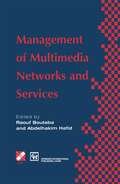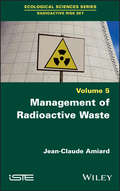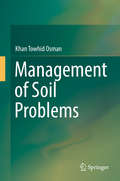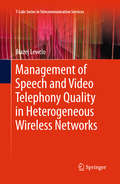- Table View
- List View
Management of Microbial Resources in the Environment
by Abdul Malik, Elisabeth Grohmann and Madalena AlvesThis volume details the exploration, collection, characterization, evaluation and conservation of microbes for sustainable utilization in the development of the global as well as national economies, e.g. in agriculture, ecosystems, environments, industry and medicine. Many research institutes and universities all over the world carry out microbiological and biotechnological research, which generates substantial genomic resources such as cDNA libraries, gene constructs, promoter regions, transgenes and more valuable assets for gene discovery and transgenic product development. This work provides up-to-date information on the management of microbial resources in the environment. It also covers the ecology of microorganisms in natural and engineered environments. In trying to understand microbial interactions it further focuses on genomic, metagenomic and molecular advances, as well as on microbial diversity and phylogeny; ecological studies of human, animal and plant microbiology and disease; microbial processes and interactions in the environment; and key technological advances. Though not intended to serve as an encyclopedic review of the subject, the various chapters investigate both theoretical and practical aspects and provide essential basic information for future research to support continued development.
Management of Mountain Watersheds
by Thomas Hofer Eero Kubin Josef Krecek Martin HaighThe book aims to address the interdisciplinary targets of watershed management in mountain regions based on the current knowledge of the subject. The focus of the book is particularly on monitoring, research, and modelling the interactions between the climate, water cycle, and aquatic ecosystem. The issues of watershed management in mountain regions in different parts of Europe, Africa, America and Asia have been the central theme of the book, which is basically divided into five sections: Institutional aspects in control of mountain regions; Stream-flow processes in mountain catchments; Water chemistry and biota in mountain streams and lakes; Effects of forest practices and climate change on hydrological phenomena; and Soil conservation and control of floods and landslides. The contributions have been peer-reviewed and the interdisciplinary team of authors includes experts from the specialised areas of geography, hydrology, chemistry, biology, forestry, ecology, economy and sociology. The practical applications and management strategies mentioned in the book, deal with the integrated resource management approach, based on the compromise between the development, conservation/ protection of the nature. Finally, the socio-economic and cultural aspects, and ecosystem prevalent in a mountain catchment are discussed in detail.
Management of Multimedia Networks and Services (IFIP Advances in Information and Communication Technology)
by Raouf Boutaba Abdelhakim HafidWith the continual growth in telecommunication services in today's multimedia environment, reliability and control are essential elements in the provision of services. This book addresses the need for an integration of service and management in multimedia networks in order to facilitate greater accuracy and quality in the services provided. The book aims to disseminate all facets of network and service management in broadband networks and multimedia services while providing an overview of state-of-the-art research and implementation experiences in the field.
Management of Natural Resources in a Changing Environment
by N. Janardhana Raju Wolfgang Gossel M. SudhakarThis book addresses issues related to sources of groundwater pollution such as arsenic, uranium, fluoride and their effects on human health. It discusses extensively the removal of heavy metals, arsenic and fluoride from drinking water. Bioremediation and phyto remediation on biomass productivity are treated in several chapters in the book. The volume highlights leachate characteristics analysed both in the laboratory and in field studies assessing the trace metals in rainwater.This book is a study on the judicious management of natural resources and exposes environmental problems particularly those related to pollution and bioremediation.
Management of Nutrition in Forests under Stress: Proceedings of the International Symposium, sponsored by the International Union of Forest Research Organization (IUFRO, Division I) and hosted by the Institute of Soil Science and Forest Nutrition at the Albert-Ludwigs-University in Freiburg, Germany, held on September 18–21, 1989 at Freiburg, Germany
by H. W. Zöttl Oleg I. LarichevProceedings of the International Symposium, held in Freiburg, Germany, September 18-21, 1989
Management of Phytonematodes: Recent Advances and Future Challenges
by Rizwan Ali Ansari Rose Rizvi Irshad MahmoodThis book illustrates the currently available strategies for managing phytonematodes. It discusses the latest findings on plant-pathogen-microbiome interactions and their impacts on ecosystems, and provides extensive information on the application of microorganisms in the sustainable management of phytonematodes. This is followed by an in-depth discussion of the application of potential strains of biocontrol fungi, endophytes and actinomycetes to enhance plants’ ability to fend off phytonematode attacks, leading to improved plant health. In conclusion, the book addresses new aspects like the biofabrication of nanoparticles and their application in plant disease management, and presents an extensive list for further reading.
Management of Problem Soils in Arid Ecosystems
by A. Monem BalbaManagement of Problem Soils in Arid Ecosystems examines the challenges of managing soils in arid and semiarid regions. These soils contain low organic matter, are not leached, and accumulate lime, gypsum, and/or soluble salts, requiring special management and practices. This book discusses how to identify problems, reclaim the soils, and then use them efficiently and economically. Water management and desertification in these areas are also discussed. It contains extensive references as well as 40 tables and illustrations.
Management of Problem Soils in Arid Ecosystems
by A. Monem BalbaManagement of Problem Soils in Arid Ecosystems examines the challenges of managing soils in arid and semiarid regions. These soils contain low organic matter, are not leached, and accumulate lime, gypsum, and/or soluble salts, requiring special management and practices. This book discusses how to identify problems, reclaim the soils, and then use them efficiently and economically. Water management and desertification in these areas are also discussed. It contains extensive references as well as 40 tables and illustrations.
Management Of Professionals, Revised And Expanded
by Richard Shell"Considers the common functions of managers, such as effective planning and decision-making, organizational design and staffing, directing and controlling, and delegating. Offers methods to strengthen and enhance personal leadership stule, communication skills, and workplace motivation and involvement to improve individual and organizational productivity and increase business revenues."
Management Of Professionals, Revised And Expanded
by Richard Shell"Considers the common functions of managers, such as effective planning and decision-making, organizational design and staffing, directing and controlling, and delegating. Offers methods to strengthen and enhance personal leadership stule, communication skills, and workplace motivation and involvement to improve individual and organizational productivity and increase business revenues."
The Management of Quality in Construction
by J.L. AshfordThe quality of a product or service is a measure of its ability to satisfy customer requirements. This satisfaction can be assured by the operation of a quality system which will ensure that specified requirements are met consistently and economically. The Management of Quality in Construction provides the reader with a knowledge of the principles of quality management and an understanding of how they may successfully be applied in the particular circumstances of the construction industry. The areas covered range from an historical review of traditional methods of assuring quality in the industry and how contractual arrangements have evolved, to an interpretation of quality system standards in the context of construction. Examples are given which highlight specific areas, and specialist chapters on organization structures and the techniques of quality auditing are included.
The Management of Quality in Construction
by J.L. AshfordThe quality of a product or service is a measure of its ability to satisfy customer requirements. This satisfaction can be assured by the operation of a quality system which will ensure that specified requirements are met consistently and economically. The Management of Quality in Construction provides the reader with a knowledge of the principles of quality management and an understanding of how they may successfully be applied in the particular circumstances of the construction industry. The areas covered range from an historical review of traditional methods of assuring quality in the industry and how contractual arrangements have evolved, to an interpretation of quality system standards in the context of construction. Examples are given which highlight specific areas, and specialist chapters on organization structures and the techniques of quality auditing are included.
Management of Radioactive Waste
by Jean-Claude AmiardThe classification of radioactive waste varies from state to state. This results in different management procedures for each country, while following IAEA and OECD/NEA recommendations.Radioactive waste comes from numerous sources. The largest volumes are generated by the decommissioning and dismantling of nuclear facilities. Long-lived, medium- and high-activity waste – categorized as the most hazardous types of waste – are in fact largely produced by nuclear power reactors, spent fuel reprocessing plants and nuclear accidents.Final disposal of very low-activity, low-activity and very short-lived waste is well controlled. However, final solutions for certain categories, including long-lived waste, sorted waste and spent graphite waste, are not yet in place.Management of Radioactive Waste reviews all the possible solutions and presents those chosen by the various states, including a chapter detailing policy on radioactive waste management, taking France as an example.
Management of Radioactive Waste
by Jean-Claude AmiardThe classification of radioactive waste varies from state to state. This results in different management procedures for each country, while following IAEA and OECD/NEA recommendations.Radioactive waste comes from numerous sources. The largest volumes are generated by the decommissioning and dismantling of nuclear facilities. Long-lived, medium- and high-activity waste – categorized as the most hazardous types of waste – are in fact largely produced by nuclear power reactors, spent fuel reprocessing plants and nuclear accidents.Final disposal of very low-activity, low-activity and very short-lived waste is well controlled. However, final solutions for certain categories, including long-lived waste, sorted waste and spent graphite waste, are not yet in place.Management of Radioactive Waste reviews all the possible solutions and presents those chosen by the various states, including a chapter detailing policy on radioactive waste management, taking France as an example.
Management of River Basins and Dams: The Zambezi River Basin
by M. J. TumbareThe Zambezi river basin is the fourth largest river basin in Africa and drains a total of some 1350.000 square km. The basin drains eight countries: Angola, Botswana, Malawi, Mozambique, Namibia, Tanzania, Zambia and Zimbabwe. The river flows over the famous Victoria Falls into the third largest artificial lake in the world: Lake Kariba. The Zambezi Basin is rich in natural resources and has a large hydro-power potential. This volume contains 37 papers which have been published in international journals, or presented at international conferences by the Zambezi River Authority staff. The topics covered include: Dam Safety, Rehabilitation and Maintenance, Environment and Health, Hydrology, Limnology, Information Systems, Water Resource Management, Hydropower Development and Socio-Economic Issues.
Management of River Basins and Dams: The Zambezi River Basin
by M. J. TumbareThe Zambezi river basin is the fourth largest river basin in Africa and drains a total of some 1350.000 square km. The basin drains eight countries: Angola, Botswana, Malawi, Mozambique, Namibia, Tanzania, Zambia and Zimbabwe. The river flows over the famous Victoria Falls into the third largest artificial lake in the world: Lake Kariba. The Zambezi Basin is rich in natural resources and has a large hydro-power potential. This volume contains 37 papers which have been published in international journals, or presented at international conferences by the Zambezi River Authority staff. The topics covered include: Dam Safety, Rehabilitation and Maintenance, Environment and Health, Hydrology, Limnology, Information Systems, Water Resource Management, Hydropower Development and Socio-Economic Issues.
Management of Shared Fish Stocks
by Andrew I. L. Payne Stuart I. Rogers Carl M. O'BrienCelebrating the centenary of the Centre for Environment Fisheries and Aquaculture Science (CEFAS) Fisheries Research Laboratory at Lowestoft, UK, this peer-reviewed, edited tome discusses four interwoven themes: · The consequences and management of unregulated/unreported catches · Competition · External drivers and resource behaviour · Ecosystems and migration With contributions from fisheries scientists, policy-makers and managers from more than twenty countries, this international volume has evolved from the CEFAS symposium on International Approaches to Management of Shared Fish Stock- Problems and Future Directions. The editors, Andrew Payne, Carl O’Brien and Stuart Rogers, have succeeded in bringing together the research of over sixty participants into an essential source of reference for all those involved in, or studying, fisheries management across the globe.
Management of Shared Groundwater Resources: The Israeli-Palestinian Case with an International Perspective (Natural Resource Management and Policy #18)
by Eran Feitelson Marwan HaddadMost of the world's freshwater resources in the liquid state (i.e. not in glaciers and polar caps) are underground. As the population grows and demand for water rises, reliance on groundwater increases. In many cases the groundwater underlies boundaries, or is part of a hydraulic system that crosses boundaries. In such cases there is always the danger that the 'prisoner's dilemma' will run its course and all parties will compete over who will pump the most water, ultimately destroying the storage potential to the detriment of future generations of all parties reliant on the groundwater. This book explores the options and means for averting this all too realistic scenario by managing these shared groundwater resources. Nowhere is the likelihood of excessive use of groundwater greater than in the water-scarce Middle East, and especially in the Israeli-Palestinian case. Here both sides are heavily reliant on a shared aquifer, the Mountain aquifer. This book is the outcome of a seven-year effort to find ways to manage the Mountain aquifer, perhaps the most important resource shared by Israelis and Palestinians. As part of this cooperative study, four workshops were held in which a selected number of Palestinian, Israeli, and foreign experts were invited. The chapters in this book were originally presented in one of these workshops. To these papers introductory and concluding chapters were added.
Management of Soil Problems
by Khan Towhid OsmanSoils are neither good nor bad, but some have inherent or acquired characteristics that may or may not suit our intended use. Unsuitable characteristics are considered to be soil problems, soil constraints or soil limitations. Only twelve percent of global land is right for agricultural production without much limitation. Some soils have severe limitations for crop production. These soils are so called ‘problem soils’. Many of them do not have enough fertility to be productive; some are arid and saline; some are very sandy and dry; and some are wet and waterlogged for most of the growing season. The global demand for food, wood, fuel, fiber, medicine and other plant products for the 7.2 billion current world population has created such an immense pressure on global soil resources that even the most fertile soils are losing their productive capacity. We are being compelled to bring more and more unsuitable or marginally suitable soils under cultivation. Unless innovative and integrated soil, crop and environmental management practices are adopted for their improvement and sustainable use, further degradation is inevitable. This book, Management of Soil Problems, identifies the problems and discusses management options in a smooth and reader-friendly style. It will be useful for students and professionals of soil science, agriculture, forestry, geography and environmental sciences.
Management of Speech and Video Telephony Quality in Heterogeneous Wireless Networks (T-Labs Series in Telecommunication Services)
by Błażej LewcioThis book shows how networking research and quality engineering can be combined to successfully manage the transmission quality when speech and video telephony is delivered in heterogeneous wireless networks. Nomadic use of services requires intelligent management of ongoing transmission, and to make the best of available resources many fundamental trade-offs must be considered. Network coverage versus throughput and reliability of a connection is one key aspect, efficiency versus robustness of signal compression is another. However, to successfully manage services, user-perceived Quality of Experience (QoE) in heterogeneous networks must be known, and the perception of quality changes must be understood. These issues are addressed in this book, in particular focusing on the perception of quality changes due to switching between diverse networks, speech and video codecs, and encoding bit rates during active calls.
Management of Structure Formation and Properties of Cement Concretes (Innovation and Discovery in Russian Science and Engineering)
by Levon R. Mailyan Sergey A. Stel’makh Evgenii M. Shcherban' Mikhail G. Kholodnyak Alla S. Smolyanichenko Ivan A. Parinov Alexander V. CherpakovThe book presents Russian experience in researching and developing theoretical and experimental problems of heavy concrete elements and constructions with functionally gradient structure, manufactured by using mechanical and electromagnetic vibrations, and broadly utilized in different areas of industry. Original theoretical, experimental and numerical methods are developed for the analysis and design of the aggregate and local characteristics of vibrated, centrifuged and vibro-centrifuged concrete rings and columns. The promising experimental techniques and results presented in this volume have been supported by Russian patents and used for improvement of reinforced concrete products.
Management of Technological Change: The Great Challenge of Management for the Future
by E.G. FrankelTechnological change has been recognized as the major contributor to economic growth and has become one of the most important challenges to policy makers and managers. Many excellent books and papers have been written on the subject. Most of these deal with the macro or micro economic impact of technological change or the technological change process from invention and discovery to innovation, development, and final maturity as well as ultimate obsolescence of technology. This book is designed to present technological change as a decision process and explain the use of recently developed methods for the effective management of technological change. In particular, techniques for the effective choice among technological alternatives, timing of the introduction of new technology both in terms of its own status and that of the technology to be replaced if any, and the rate and method of introduction of new technology are presented. Management of technology is a complex decision process which is affected by both internal and external factors. The purpose of this book is to instruct the reader in effective technology deciSion making which involves the evaluation of the status of technology in use if any, the problem to be solved or output to be obtained, determination of environmental and internal constraints, and the competitive environment or market conditions which affect the technology decisions.
Management of Technology: Managing Effectively in Technology-Intensive Organizations
by Hans J. Thamhain* Presents assessment methods for organization and management processes. * Provides special tools and techniques for managing and organizing R&D, new product, and project-oriented challenges. * Includes real-world case studies.
Management of Technology: Managing Effectively in Technology-Intensive Organizations
by Hans J. Thamhain* Presents assessment methods for organization and management processes. * Provides special tools and techniques for managing and organizing R&D, new product, and project-oriented challenges. * Includes real-world case studies.
Management of Transboundary Rivers and Lakes (Water Resources Development and Management)
by Olli Varis Cecilia Tortajada Asit K. BiswasTransboundary rivers and lakes are often the remaining new sources of water that can be developed for human uses. These water sources were not used in the past because of the many complexities involved. Written and edited by the world’s leading water and legal experts, this unique and authoritative book analyses the magnitudes of the transboundary water problems in different parts of the world. It also examines difficulties and constraints faced to resolve these problems.



















